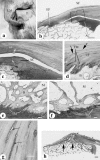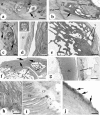The functional anatomy of the human anterior talofibular ligament in relation to ankle sprains
- PMID: 12090392
- PMCID: PMC1570702
- DOI: 10.1046/j.1469-7580.2002.00050.x
The functional anatomy of the human anterior talofibular ligament in relation to ankle sprains
Abstract
The anterior talofibular ligament is the most commonly injured ligament in the ankle. Despite considerable interest in the clinical outcome of treatment protocols, we do not know whether the distinctive pattern of localization of the injuries relates to regional differences in the structure and molecular composition of the ligament. To address this issue, ligaments were examined by histology and immunohistochemistry. Differences in the structure of its two attachments (i.e. entheses) were evaluated with quantitative, morphometric techniques, and regional differences in the distribution of collagens, glycosaminoglycans and proteoglycans were determined qualitatively by immunolabelling. Morphometric analyses showed that bone density was less at the fibular attachment, but that enthesis fibrocartilage was more prominent. Immunohistochemistry revealed the presence of a fibrocartilage (containing type II collagen and aggrecan) at the site where the ligament wraps around the lateral talar articular cartilage in a plantarflexed and inverted foot: the fibrocartilage is regarded as an adaptation to resisting compression. We propose that avulsion fractures are less common at the talar end of the ligament because (1) bone density is greater here than at the fibular enthesis, and (2) stress is dissipated away from the talar enthesis by the 'wrap-around' fibrocartilaginous character of the ligament near the talar articular facet.
Figures


References
-
- Attarian DE, McCrackin HJ, Devito DE, McElhsney JH, Garrett WE. Biomechanical charactersitics of human ankle ligaments. Foot Ankle. 1985;6:54–58. - PubMed
-
- Benjamin M, Ralphs JR. Functional and development anatomy of tendon and ligaments. In: Gordon SL, Blair SJ, Fine LJ, editors. In Repetitive Motion Disorders of the Upper Extremity. Rosemont, Illinois: American Academy of Orthopaedic Surgeons; 1995. pp. 185–203.
MeSH terms
Substances
LinkOut - more resources
Full Text Sources
Medical

